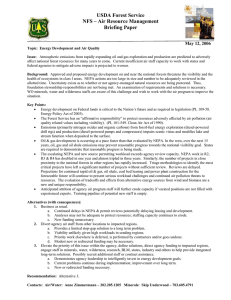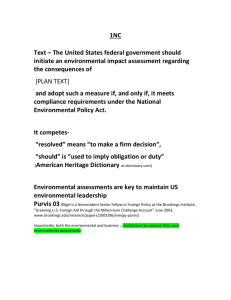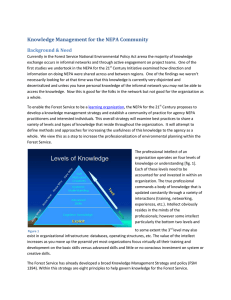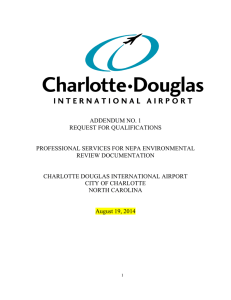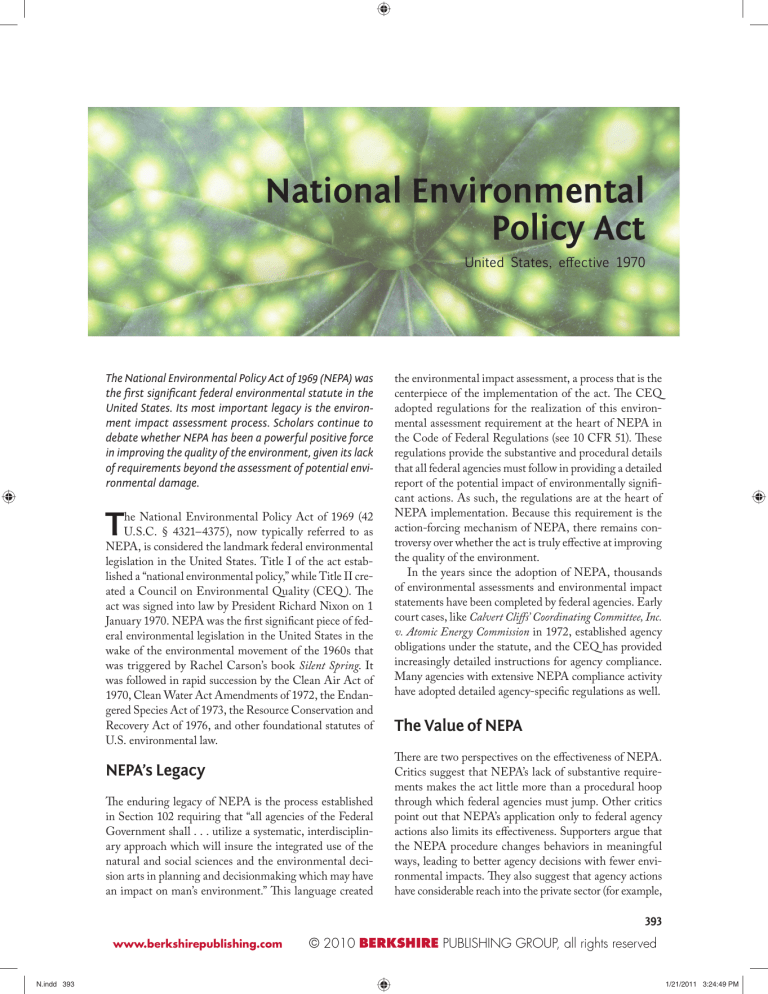
National Environmental
Policy Act
United States, effective 1970
The National Environmental Policy Act of 1969 (NEPA) was
the first significant federal environmental statute in the
United States. Its most important legacy is the environment impact assessment process. Scholars continue to
debate whether NEPA has been a powerful positive force
in improving the quality of the environment, given its lack
of requirements beyond the assessment of potential environmental damage.
T
he National Environmental Policy Act of 1969 (42
U.S.C. § 4321–4375), now typically referred to as
NEPA, is considered the landmark federal environmental
legislation in the United States. Title I of the act established a “national environmental policy,” while Title II created a Council on Environmental Quality (CEQ ). The
act was signed into law by President Richard Nixon on 1
January 1970. NEPA was the first significant piece of federal environmental legislation in the United States in the
wake of the environmental movement of the 1960s that
was triggered by Rachel Carson’s book Silent Spring. It
was followed in rapid succession by the Clean Air Act of
1970, Clean Water Act Amendments of 1972, the Endangered Species Act of 1973, the Resource Conservation and
Recovery Act of 1976, and other foundational statutes of
U.S. environmental law.
NEPA’s Legacy
The enduring legacy of NEPA is the process established
in Section 102 requiring that “all agencies of the Federal
Government shall . . . utilize a systematic, interdisciplinary approach which will insure the integrated use of the
natural and social sciences and the environmental decision arts in planning and decisionmaking which may have
an impact on man’s environment.” This language created
the environmental impact assessment, a process that is the
centerpiece of the implementation of the act. The CEQ
adopted regulations for the realization of this environmental assessment requirement at the heart of NEPA in
the Code of Federal Regulations (see 10 CFR 51). These
regulations provide the substantive and procedural details
that all federal agencies must follow in providing a detailed
report of the potential impact of environmentally significant actions. As such, the regulations are at the heart of
NEPA implementation. Because this requirement is the
action-forcing mechanism of NEPA, there remains controversy over whether the act is truly effective at improving
the quality of the environment.
In the years since the adoption of NEPA, thousands
of environmental assessments and environmental impact
statements have been completed by federal agencies. Early
court cases, like Calvert Cliffs’ Coordinating Committee, Inc.
v. Atomic Energy Commission in 1972, established agency
obligations under the statute, and the CEQ has provided
increasingly detailed instructions for agency compliance.
Many agencies with extensive NEPA compliance activity
have adopted detailed agency-specific regulations as well.
The Value of NEPA
There are two perspectives on the effectiveness of NEPA.
Critics suggest that NEPA’s lack of substantive requirements makes the act little more than a procedural hoop
through which federal agencies must jump. Other critics
point out that NEPA’s application only to federal agency
actions also limits its effectiveness. Supporters argue that
the NEPA procedure changes behaviors in meaningful
ways, leading to better agency decisions with fewer environmental impacts. They also suggest that agency actions
have considerable reach into the private sector (for example,
393
www.berkshirepublishing.com
N.indd 393
© 2010 Berkshire Publishing Group, all rights reserved
1/21/2011 3:24:49 PM
394 • BERKSHIRE ENCYCLOPEDIA OF SUSTAINABILITY: THE L AW AND POLITICS OF SUSTAINABILITY
granting a permit is an “action” under NEPA), extending
the act’s positive impacts.
Criticism
Critics of NEPA focus on its procedural emphasis. Federal
agencies follow a simple logic model in their compliance
with the act. Once a proposed “action” is identified, the
agency must determine whether it will have a “significant
impact on the human environment.” If the agency is unsure,
it must complete an Environmental Assessment (EA) to
determine whether the action may pose a significant impact.
If the action does not, the agency issues a Finding of No
Significant Impact (FONSI) and proceeds with the action.
If the action does have a significant impact, the agency must
prepare an Environmental Impact Statement (EIS) documenting the environmental impacts as well as those of
alternative actions. Once the EIS is complete, the agency
decides whether to proceed with the action and issues a
Record of Decision (ROD). Nothing in the act itself prohibits actions with adverse environmental impacts as long
as they have been identified and considered when making
the decision. For critics, the lack of requirements
beyond the assessment phase makes the act
ineffectual.
Support
Supporters of NEPA point to
two benefits of these procedural requirements, suggesting that the act has been a
positive force for environmental improvement. First, they
suggest that agencies who
take the CEQ procedural
requirements seriously
make better decisions
because the process
forces them to think
about alternate means
of accomplishing
agency missions to
create lesser environmental impact,
or about means to
mitigate unavoidable impacts. Of
course, it is logically impossible
to judge whether
the decisions made
by the agencies are
www.berkshirepublishing.com
N.indd 394
better than those that would have been made without the
process.
Second, EAs and EISs become important sources of
information for opponents of agency actions, and in this
sense NEPA might be considered the first of the so-called
new tools for environmental protection. In the 1990s, a
number of students of environmental policy began to search
for alternatives to command-and-control techniques and
economic incentives (taxes, subsidies, cap and trade). “New
tools” became the term that applied to information-based,
educational programs aimed at changing human behaviors.
A good example is the Toxics Release Inventory (TRI) of
the Emergency Planning and Community Right to Know
Act of 1986. Anecdotal evidence suggests that the simple requirement that emitters inform the public of toxics
release changes their behavior, and fewer toxics are emitted as a result. Likewise, NEPA’s procedural requirement
resulting in the release of information about environmental impacts may both encourage agencies to make better
decisions and provide the public with better information
to challenge the wisdom of decisions.
Belief in the value of NEPA procedures resulted in
encouragement for the integration of the NEPA
process with the adoption of Environmental Management Systems (EMS)
by federal agencies. In 2000,
the Clinton administration
required agencies to adopt
EMSs by Executive Order
(#13148), although this
was not explicitly tied
to NEPA.
NEPA’s Impact
The debate over the
value of NEPA in
terms of improved
env ironmenta l
quality is unresolved, yet NEPA as
been widely copied. A
number of U.S. states
have adopted NEPAlike requirements for
state agency actions,
so-called miniNEPAs. Many of
these are modeled
after NEPA in that
they require state
agencies to assess the
impacts of their agency
© 2010 Berkshire Publishing Group, all rights reserved
1/21/2011 3:24:55 PM
NATIONAL ENVIRONMENTAL POLICY ACT • 395
actions. Other states extend the environmental impact
assessment concept to the private sector or to local governments when these entities are pursuing activities that
require state agency permits.
Globally, environmental impact assessment is important in both governmental and nongovernmental organization contexts. If the core of NEPA is the idea of
environmental impact assessment, this idea has blossomed
since 1960 in the United States and far beyond. Environmental impact assessments are a routine part of the
work of international organizations, from the European
Commission to the World Bank. The United Nations
Environment Programme (UNEP) provides training
to developing countries in impact assessment, and the
Organisation for Economic Co-operation and Development (OECD) provides member-states with advice on
how to use environmental impact assessment as part of
their development aid programs. Professional associations
dedicated to the practice of impact assessment exist not
only in the United States—the National Association of
Environmental Professionals, for instance—but also globally. The International Association for Impact Assessment
claims 1,600 members from over 120 nations.
Mark W. ANDERSON
University of Maine
www.berkshirepublishing.com
N.indd 395
See also Clean Air Act; Clean Water Act; Development,
Sustainable—Overview of Laws and Commissions; Ecosystem Management; Endangered Species Act; Environmental Law—United States and Canada; Natural
Resources Law; Silent Spring; Wilderness Act
FURTHER READINGS
Bass, Ronald E.; Herson, Albert I.; & Bogdan, Kenneth M. (2001). The
NEPA book. Point Arena, CA: Solano Press.
Caldwell, Lynton K. (1998). The National Environmental Policy Act: An
agenda for the future. Bloomington: Indiana University Press.
Calvert Cliffs’ Coordinating Committee, Inc. v. Atomic Energy Commission,
44 F.2d 1109 (D.C. Cir. 1971).
Dietz, Thomas, & Stern, Paul C. (2002). New tools for environmental
protection. Washington, DC: National Academy Press.
Eccleston, Charles H. (1998). A strategy for integrating NEPA with
EMS and ISO 14000. Environmental Quality Management, 7(3),
9–17.
Executive Office of the President. (2000). Executive Order 13148—
Greening the government through leadership in environmental management. Federal Register, 65(81), 24595–24606.
Karkkainen, Bradley C. (2002). Toward a smarter NEPA: Monitoring
and managing government’s environmental performance. Columbia
Law Review, 102(4), 903–972.
U.S. Nuclear Regulatory Commission. (1984). NRC Regulations Title
10, Code of Federal Regulations, Part 51—Environmental Protection
Regulations for Domestic Licensing and Related Regulatory
Functions. Retrieved August 11, 2010, from http://www.nrc.gov/
reading-rm/doc-collections/cfr/part051/
© 2010 Berkshire Publishing Group, all rights reserved
1/21/2011 3:25:46 PM


